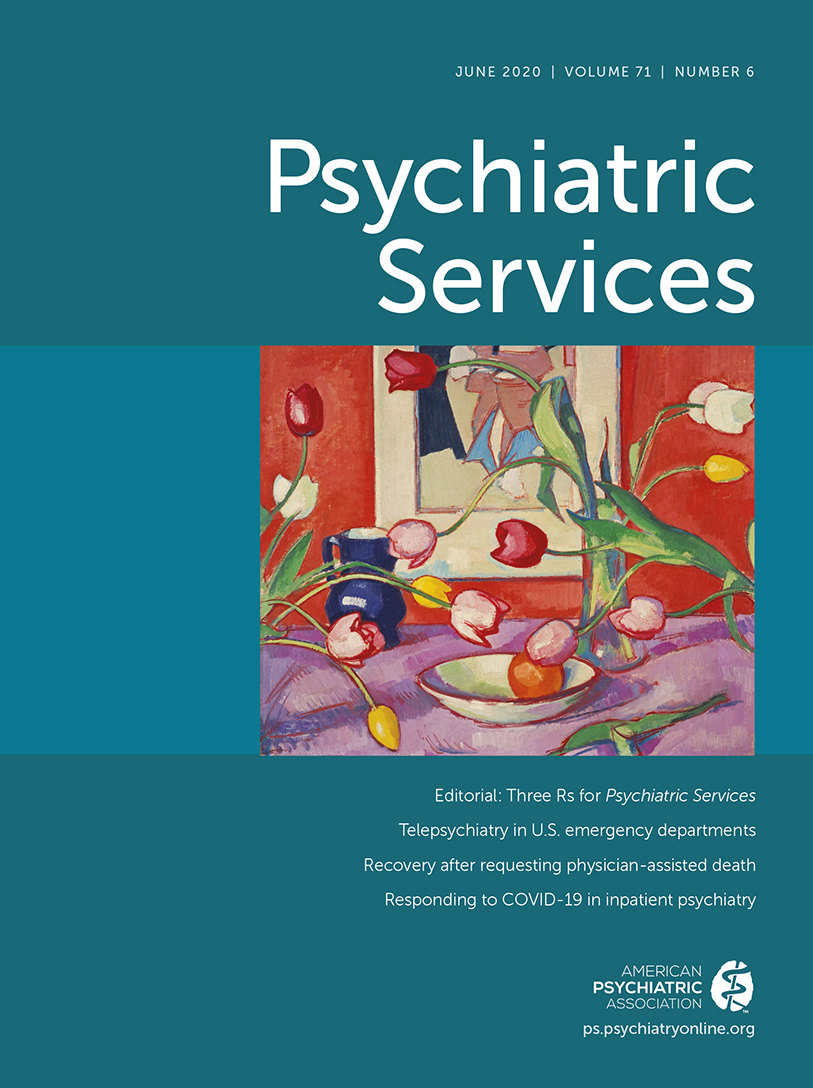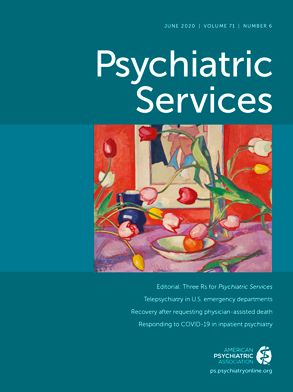In an increasing number of jurisdictions, physician-assisted death is legal (
1). An important justification for this option is that physicians should be able to relieve the unbearable and irremediable suffering of mentally competent patients, even by assisting their death (
2). The Netherlands, Belgium, Luxembourg, and Switzerland are the only countries where psychiatric patients are granted legal access to physician-assisted death (
3). Since 2012, the prevalence of physician-assisted death due to psychiatric suffering in the Netherlands has increased, peaking at 83 deaths in 2017. In 2018, 1.1% (N=67) of all cases of physician-assisted death were due to psychiatric suffering (
4). A majority of these patients were women over age 50 years who suffered from a complex combination of psychiatric disorders and had long treatment histories. About 50% of these patients were diagnosed as having depression or personality disorders (
5,
6).
The increasing number of physician-assisted deaths in psychiatry might be related to the establishment of the Expert Centre on Euthanasia (ECE; formerly called the End of Life Clinic) in the Netherlands, an organization of physicians who are specialized in giving advice on and performing complex physician-assisted death requests. In 2018, ECE received 640 requests for physician-assisted death from psychiatric patients and assisted with 56 deaths (9%). What happened to the 91% of psychiatric patients who requested but did not receive physician-assisted death is unclear (
7). This Open Forum introduces the case of a psychiatric patient who asked his physician for assistance in dying but recovered during the assessment process. We will use this case to reflect on how to deal with uncertainty about physician-assisted death of psychiatric patients and to argue for implementation of a due-diligence procedure, such as the one proposed in the Dutch Psychiatric Association’s recent guideline concerning this issue.
Case Description
A 36-year-old man with a history of attention-deficit hyperactivity disorder, drug abuse, psychological trauma, obsessive-compulsive personality disorder, and therapy-resistant schizophrenia had been experiencing psychotic episodes with delusions and imperative acoustic hallucinations (hearing voices) for 10 years. After the second psychotic episode was treated 8 years ago, the patient repeatedly heard songs from his childhood throughout the day. Their effect on the patient and their intensity increased when his mood worsened and when he was in a stressful environment. This new symptom was initially interpreted as an acoustic hallucination, and for several years, the patient was unsuccessfully treated with antipsychotics, including clozapine. Hearing these songs became increasingly unbearable for the patient and eventually resulted in a request for physician-assisted death. He contacted the ECE. After an assessment period of 1 year, the ECE referred him to an academic hospital for an obligatory second opinion. During admission, the patient’s symptoms were carefully analyzed, and the songs were recognized as intrusive thoughts and not psychotic phenomena. Treatment started with 20 mg of citalopram, which within 3 weeks led to a decrease of the songs the patient heard—a significant clinical improvement. Afterward, cognitive-behavioral therapy was added to the pharmacological treatment, and a few weeks later the patient reached full remission, which continued through the day of this Open Forum’s submission, 9 months later. As of this writing, the patient has withdrawn his request for physician-assisted death.
Discussion
This case highlights the complexity of physician-assisted death for psychiatric patients. The patient’s recovery, of course, was a relief for all parties involved. Yet, an obvious question presents itself: what should clinicians think of the fact that this patient might have died if the diagnosis had not been revisited and no new treatment was started? Two opposing answers can be given. On one hand, this near miss may be used as an argument for banning psychiatric patients from physician-assisted death. On the other hand, it may be concluded that the procedure worked: in the end, the patient was properly diagnosed and adequately treated, after which he withdrew his request. Moreover, if he had not sought the help of the ECE, he may not have been referred for a second opinion, and his suffering might have continued. These arguments provoke several ethical questions, two of which will be discussed here. First, how does one reach a justified conclusion on the irremediability of a patient’s suffering, given the uncertainty about diagnosis and prognosis? Second, what conditions are required for physician-assisted death due to psychiatric suffering?
Dealing with uncertainty.
Because of the variety of explanatory models and the unclear biological basis of psychiatric disorders, there is always room for uncertainty. Some authors argue that this uncertainty makes physician-assisted death morally inadmissible for psychiatric patients (
8,
9). Others argue that absolute certainty about a prognosis is epistemologically impossible and therefore unreasonable (
10). Schuklenk and van de Vathorst (
11) mention that uncertainty should be discussed with the patient. If he or she understands this uncertainty after adequate counseling and still requests physician-assisted death, why should the right to self-determination be restricted? The case presented here illustrates the high level of uncertainty common in psychiatric clinical practice. Meanwhile, it shows that discussing the need for a specialized second opinion before a request for physician-assisted death can be met, and actually obtaining this second opinion, can be regarded as a justifiable way of dealing with this uncertainty.
The need for a thorough due-diligence procedure.
If physician-assisted death is made possible for psychiatric patients, a thorough due-diligence procedure should be implemented. In 2018, the Dutch Psychiatric Association reformulated the guideline concerning physician-assisted death among patients with a psychiatric disorder, aiming “to provide a contemporary, thorough procedural framework that is both applicable to everyday practice and complies with ethical standards” (
12). The guideline offers a comprehensive framework for the entire procedure, specifically tailored to psychiatric patients.
The procedure is composed of four phases and involves at least three physicians, two of whom must be psychiatrists. The first phase, the request phase, starts when a patient requests physician-assisted death. In this phase, the crucial goals are to create an open and safe environment to discuss the patient’s death wish, to assess whether there is an acute risk of suicide, to ascertain whether those close to the patient have been informed and their views on the matter, and to give clear information about the (extensive) procedure that will follow. In the second phase, the assessment phase, the physician investigates whether all clinical and legal requirements have been met. Above all, the physician ascertains whether the request is voluntary and well considered, whether the patient’s suffering is unbearable and without prospect for improvement, whether the patient is informed about the prognosis, and whether there are other reasonable alternatives. This phase often takes several months and entails at least one obligatory second opinion performed by an independent psychiatrist (preferably one who works in an academic setting) who is specialized in the patient’s disorder. In the third phase, the consultation phase, a physician trained as a physician-assisted death consultant must assess whether all due-diligence requirements have been met. If the primary physician is not a psychiatrist, this consultant must be a psychiatrist. In the fourth phase, the executive phase, the physician assists the patient with dying by either lethal injection or by ingestion of a lethal liquid. After the death of the patient, a public coroner examines the body, and a regional review board consisting of a physician, a lawyer, and an ethicist investigates the case.
In our view, the case presented here shows the importance of an obligatory second opinion by a psychiatrist specialized in the patient’s disorder during the second phase. Psychiatry is a broad specialty, and subtle nuances can be easily missed if a clinician does not have extensive experience with a specific disorder. Utmost care and expert evaluation are required, especially in matters of life or death. Although the Dutch Psychiatric Association’s new guideline further clarifies and sharpens the due-diligence process, several challenges remain. For instance, when patients suffer from multiple disorders, it is unclear which specialist should be consulted. Furthermore, the attitudes of Dutch specialized psychiatrists concerning the obligation to seek a second opinion have not yet been investigated.
Conclusions
Physician-assisted death among patients with a psychiatric disorder is an emerging and controversial issue around the world that poses substantial ethical challenges. The fact that physician-assisted death is legal for psychiatric patients in some countries provides the opportunity to learn from actual cases. The case presented here of a psychiatric patient who requested physician-assisted death, only to recover after adequate diagnosis and treatment by an independent specialist, can serve as a basis for further debate. On one hand, it raises questions about whether relatively complex psychiatric diagnoses offer a sufficient basis for irreversible decisions such as physician-assisted death. On the other hand, it illustrates that thorough due-diligence procedures can lead to recovery, even at a late stage, which would not have occurred if the patient and the treating physician had continued treatment without a second opinion. This case shows the importance of taking the request for physician-assisted death of a patient with a psychiatric disorder seriously and investigating it further by seeking a second opinion from an independent psychiatrist specialized in the patient’s disorder.

